This web page provides information in on the activities of the Office, views of the IMF staff, and the relations between Malawi and the IMF. Additional information can be found on Malawi and IMF country page, including official IMF reports and Executive Board documents in English that deal with Malawi.
At a Glance
- Current IMF membership: 191 countries
- Malawi joined the Fund in July 19, 1965; Article VIII (December 7, 1995)
- Total Quotas: 138.8 Million
- Outstanding Purchases and Loans (SDR): 333.32 million (December 31, 2023)
- Last Article IV Consultation: Published on December 20, 2021. (Country Report No. 21/269, December 13, 2021)
Office Activities
-
Launch of the October 2019 Sub Saharan Africa Regional Economic Outlook
Presentation at the Bingu International Conference Center
November 22, 2019
-
"Macroeconomic Developments in Malawi"
Presentation at the Economic Association of Malawi (ECAMA) 2019 Annual Conference
November 7, 2019
IMF's Work on Malawi
-
Transcript of IMF Press Briefing
October 3, 2024
MS. KOZACK: Good morning, everyone. It is great to see you all here in person and online. Welcome to this IMF Press Briefing. I am Julie Kozack, Director of the Communications Department. As usual, this briefing is embargoed until 11:00 a.m. Eastern Time in the United States. I will start with some announcements and then take your questions in person on Webex and via the Press Center.
-
IMF Staff Completes Mission to Malawi
May 23, 2024
An IMF staff team led by Ms. Mika Saito visited Lilongwe from May 12 to 23, 2024 to conduct discussions on the First Review of the ECF-supported program. The program was approved by the IMF Executive Board on November 15, 2023.
-
Transcript of African Department April 2024 Press Briefing
April 19, 2024
Good morning and good afternoon and good evening for our viewers around the world. I am Tatiana Mossot with the IMF Communication department.
-
IMF Executive Board reviews the Staff-Monitored Program with Board Involvement
February 20, 2024
The Executive Board of the International Monetary Fund (IMF) completed the review of the policy on Staff-Monitored Programs with Board Involvement (PMB). This instrument helps member countries to establish a track record to access an IMF-supported program.
-
Malawi's Plan to Create a Stable and Sustainable Economy
February 2, 2024
Adherence to the authorities' macroeconomic adjustment and reform program would help Malawi overcome current and future challenges.
Fraudulent Scam Loan Application Forms Using the Name of the IMF
We would like to bring to the notice of the general public that several variants of financial scam documents purporting to be sanctioned by the International Monetary Fund (IMF) or authored by high ranking IMF officials are currently in circulation. Specifically, fake loan application forms on bogus official letterhead containing the IMF logo are in circulation in Malawi. The scam loan application forms instruct potential victims to complete and submit private information to the IMF, including personal bank details, identification numbers and other details to enable them to receive business loans. The contact information is always BOGUS and the scammers utilize unsuspecting individuals’ personal information for their fraudulent activities.For more information please see Fraudulent Scam Emails Using the Name of the IMF
Regional Economic Outlook for Sub-Saharan Africa
October 25, 2024
Sub-Saharan African countries are implementing difficult and much needed reforms to restore macroeconomic stability, and while overall imbalances have started to narrow, the picture is varied. Policymakers face three main hurdles. First, regional growth, at a projected 3.6 percent in 2024, is generally subdued and uneven, although it is expected to recover modestly next year to 4.2 percent. Second, financing conditions continue to be tight. Third, the complex interplay of poverty, scarce opportunities, and weak governance--compounded by a higher cost of living and short-term hardships linked to macroeconomic adjustment--are fueling social frustration. Within this environment, policymakers face a difficult balancing act in striving for macroeconomic stability while also working to address development needs and ensure that reforms are socially and politically acceptable. Protecting the most vulnerable from the costs of adjustment and realizing reforms that create sufficient jobs will be critical to mobilize public support.
Read the Report
Departmental Papers on Africa





